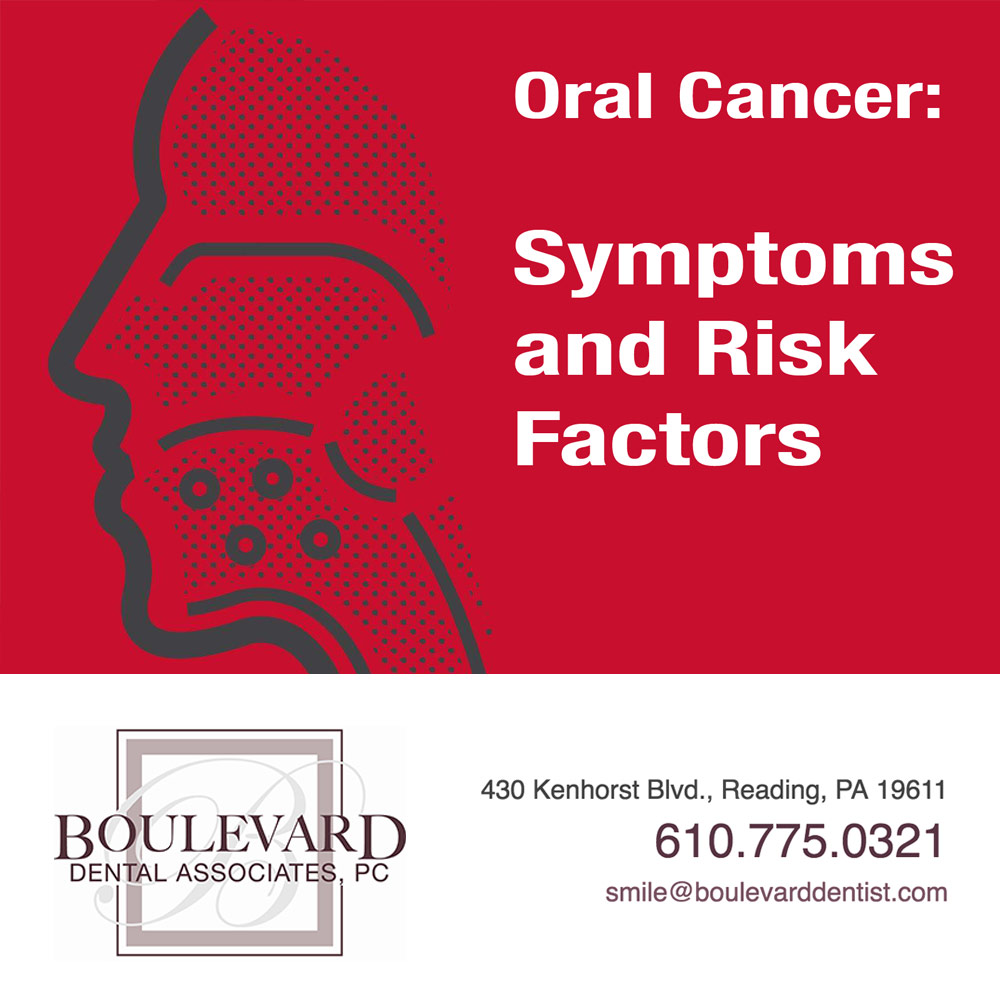
Oral cancer is far more common than you may be aware. That is why oral cancer screenings at Boulevard Dental are a part of every check-up you have with us. These oral cancer screenings are essential to the early detection of this form of cancer. That said, we also want you to know the symptoms of oral cancer and the risk factors you need to be aware of in order to help prevent it.
Statistics on Oral Cancer:
In 2018, it was estimated that 51,540 people would be diagnosed with oral cancer and cancers of the throat, tonsils and back of the tongue, states American Dental Association’s Mouth Healthy online article, “Top 5 Risk Factors for Oral Cancer.” Of these, it was estimated that 10,030 people could die as a result, with a 5-year survival rate of approximately 60%, says another ADA Mouth Healthy online article, “Oral Cancer.”
Symptoms of Oral Cancer:
The ADA “Oral Cancer” article explains that oral cancer can occur both in the oral region (your lips, the inside of your lips and cheeks, teeth, gums, the front two-thirds of your tongue and the floor and roof of your mouth) and in the oropharynx region (middle region of the throat, including the tonsils and base of the tongue).
The “Oral Cancer” article goes on to list several symptoms of oral cancer in these regions that are of concern if they do not disappear after two weeks:
- A sore or irritation that doesn’t go away
- Red or white patches
- Pain, tenderness or numbness in the mouth or lips
- A lump, thickening, rough spot, crust or small eroded area
- Difficulty chewing, swallowing, speaking or moving your tongue or jaw
- A change in the way your teeth fit together when you close your mouth
This article adds that some people experience sensations of a sore throat, the feeling that something is caught in the throat, numbness, hoarseness or a change in voice.
Risk Factors of Oral Cancer:
The ADA article, “Top 5 Risk Factors for Oral Cancer,” lists the following as risk factors for oral cancer:
Human Papilloma Virus (HPV)
This sexually transmitted disease is now associated with about 9,000 cases of head and neck cancer (specifically for cancer occurring in the back of the tongue, in or around the tonsils) diagnosed each year in the U.S. The article adds that those with HPV-related head and neck cancer tend to be younger, and that those with these cancers are often diagnosed at a later stage because they develop in harder-to-detect areas.
Gender
The article also says that men are twice more likely to get oral cancer, and it quotes The American Cancer Society as attributing this to likely heavier alcohol and tobacco use among men. In addition, more younger men are now being diagnosed with HPV-related forms of oral cancer.
Age
The article again quotes the American Cancer Society as saying that most people diagnosed with oral cancer are 55 or older, though HPV-related oral cancers are often diagnosed in people who are younger.
Tobacco
Tobacco use increases your risk of oral cancer dramatically, whether you smoke it or chew it, says the ADA article. Pipe smokers are at a higher risk for developing cancer in their lips. Chew can lead to cancer of the cheeks, gums and lips.
Alcohol
The article quotes the American Cancer Society as saying that 7 out of 10 oral cancer patients are heavy drinkers. It also quotes the Centers for Disease Control and Prevention (CDC) who define “heavy drinking” as an average of two drinks a day or more for men and an average of more than one drink a day for women.
At Boulevard Dental, we take patient education very seriously. While we regularly screen for oral cancer, you can also be on the look-out for oral cancer symptoms if you are aware of them. And we know that you will be even more empowered if you can take steps to decrease the risk factors of oral cancer before it even has a chance to develop. Our sincere hope is that you can altogether avoid the very negative results associated with an oral cancer diagnosis.
References:
American Dental Association. Oral Cancer. Mouth Healthy. “https://www.mouthhealthy.org/en/az-topics/o/oral-cancer” Accessed April 12, 2019.
American Dental Association. Top 5 Risk Factors for Oral Cancer. Mouth Healthy. “https://www.mouthhealthy.org/en/oral-cancer-slideshow” Accessed April 12, 2019.
